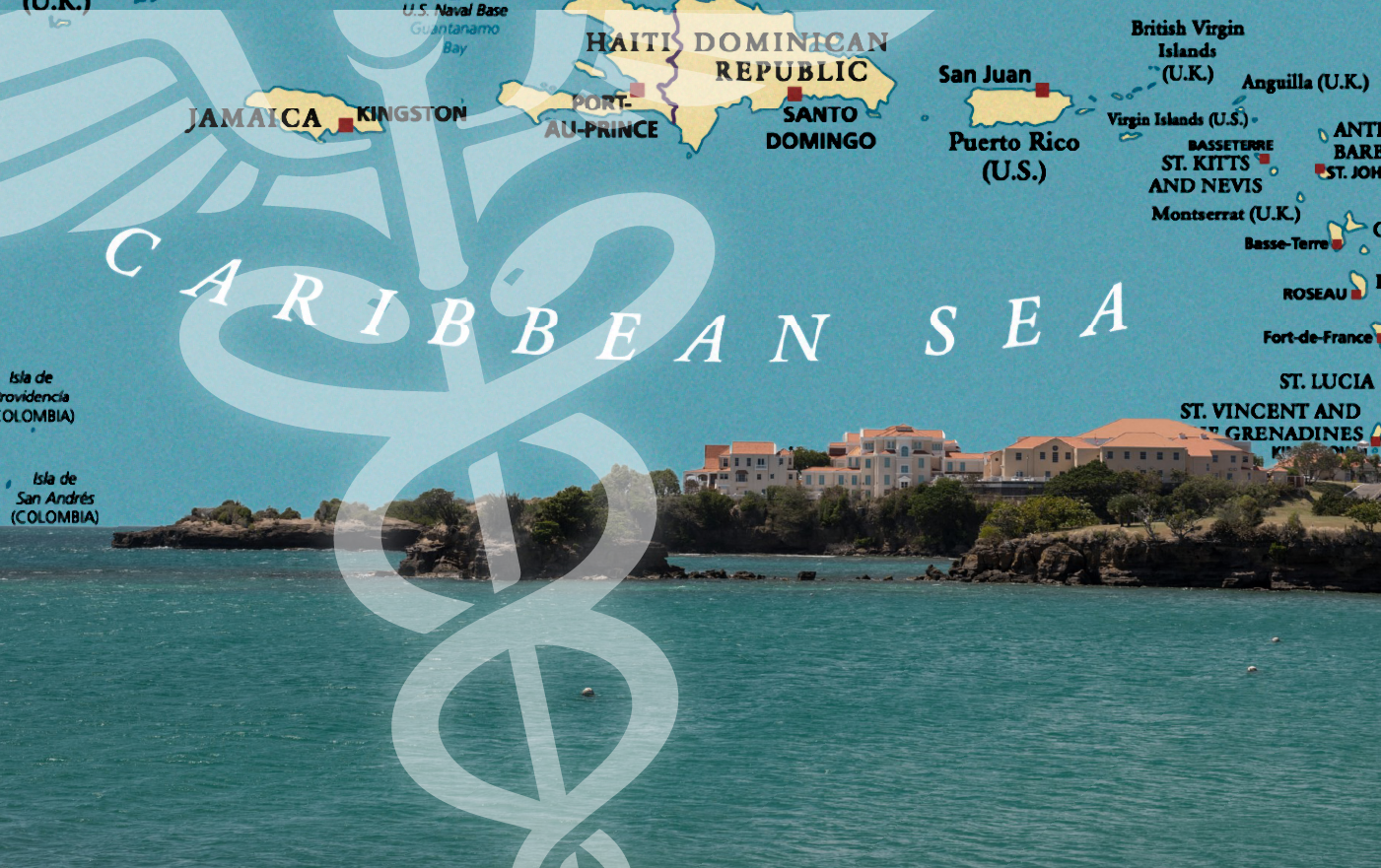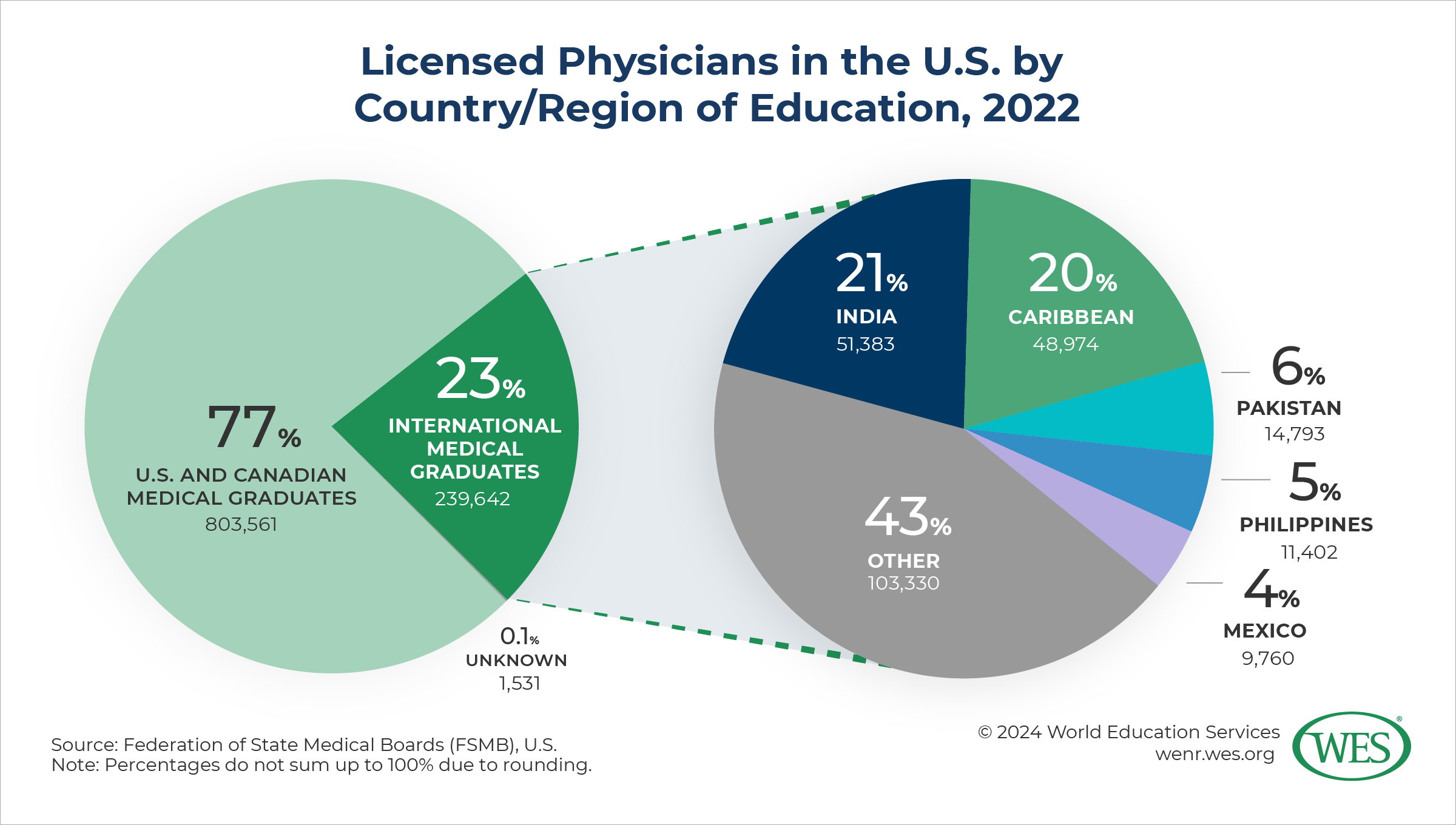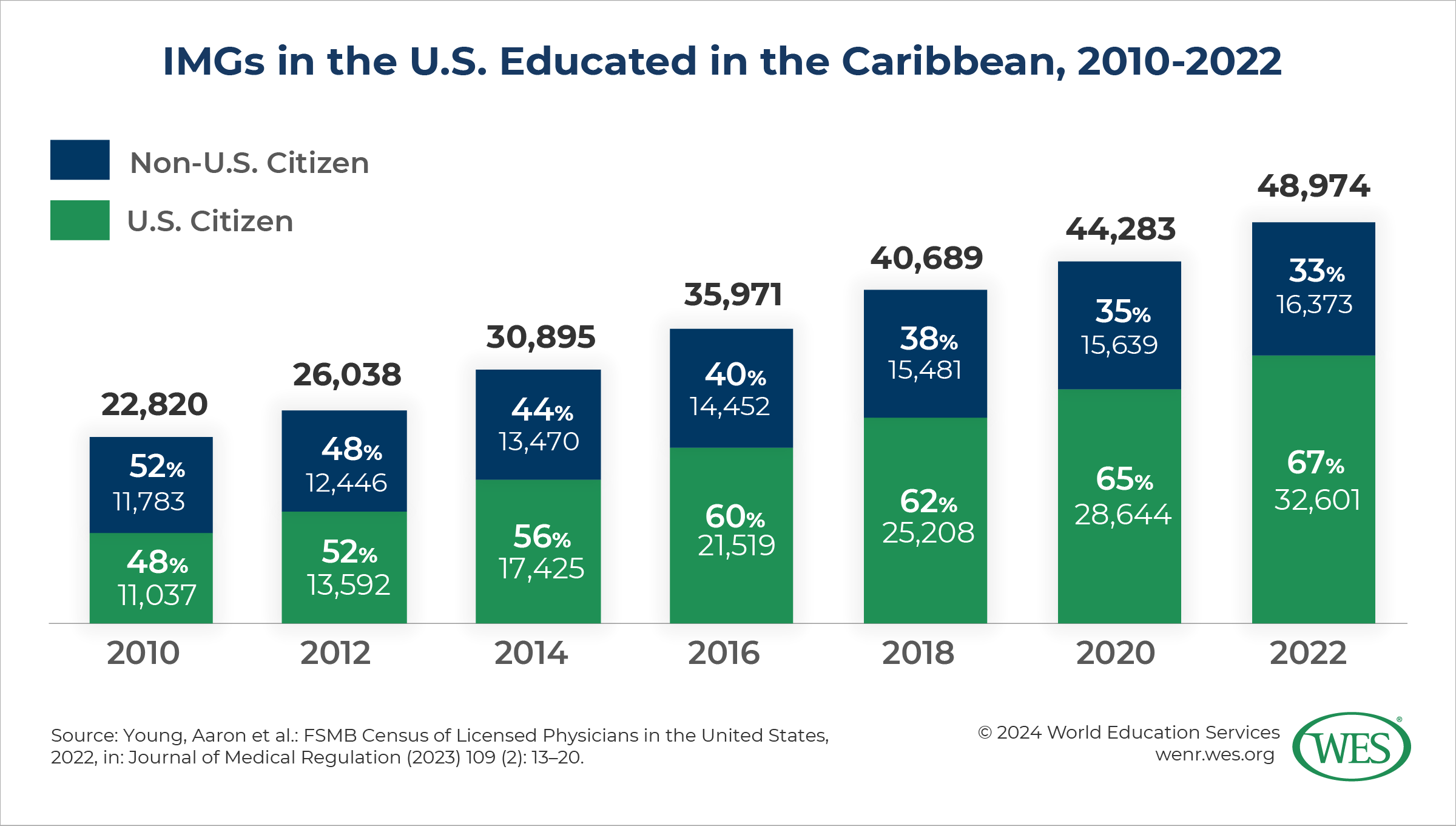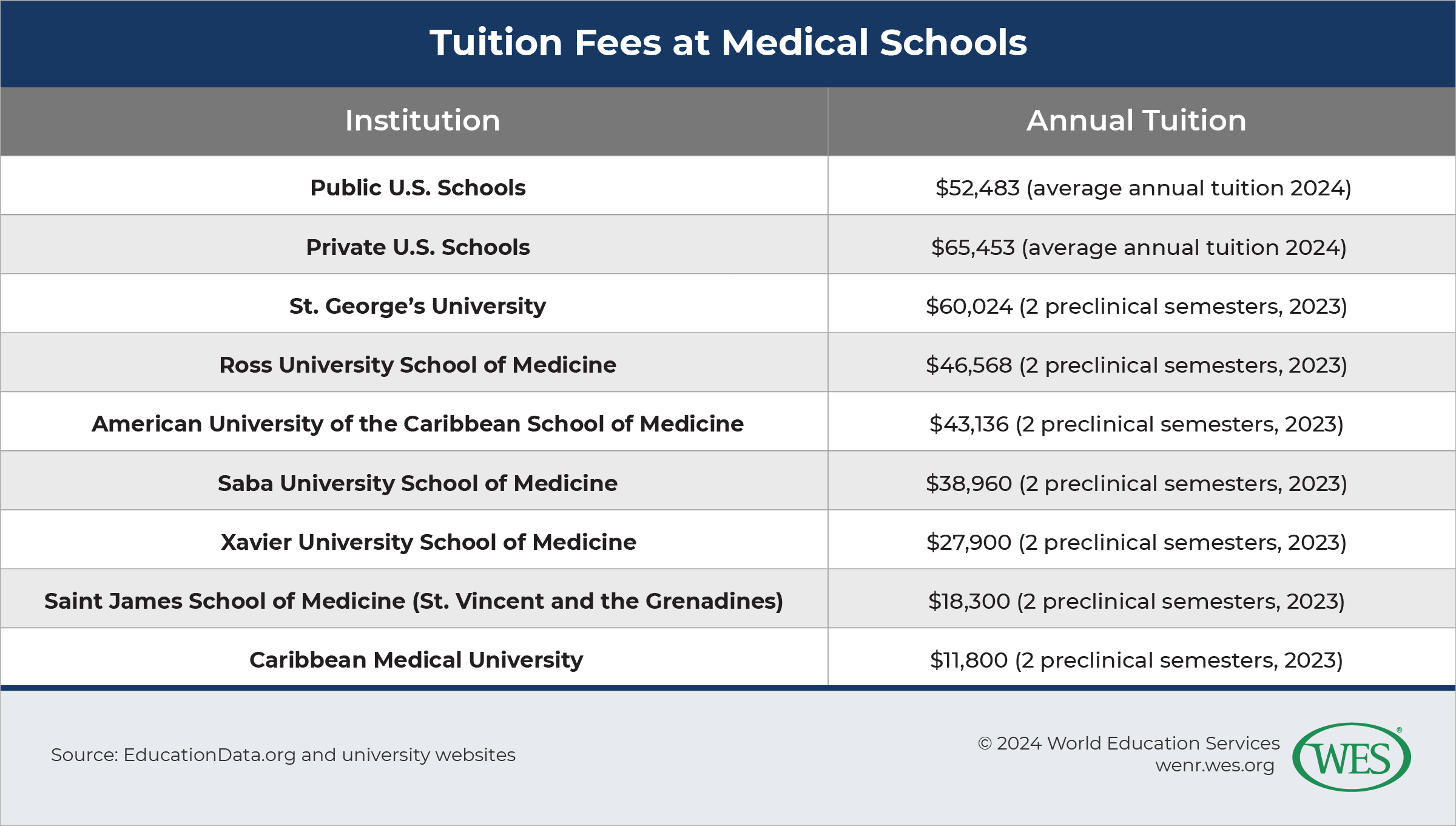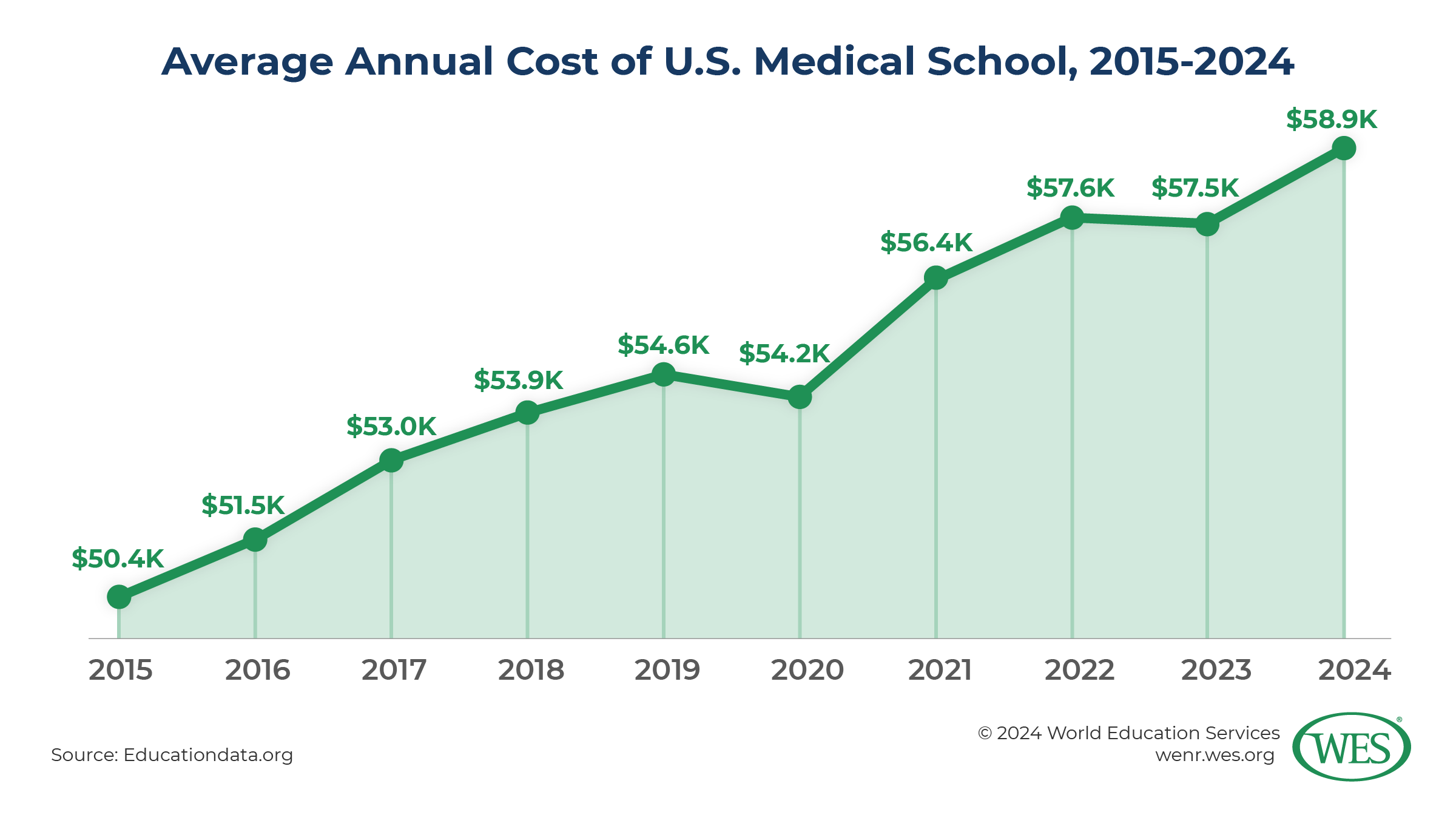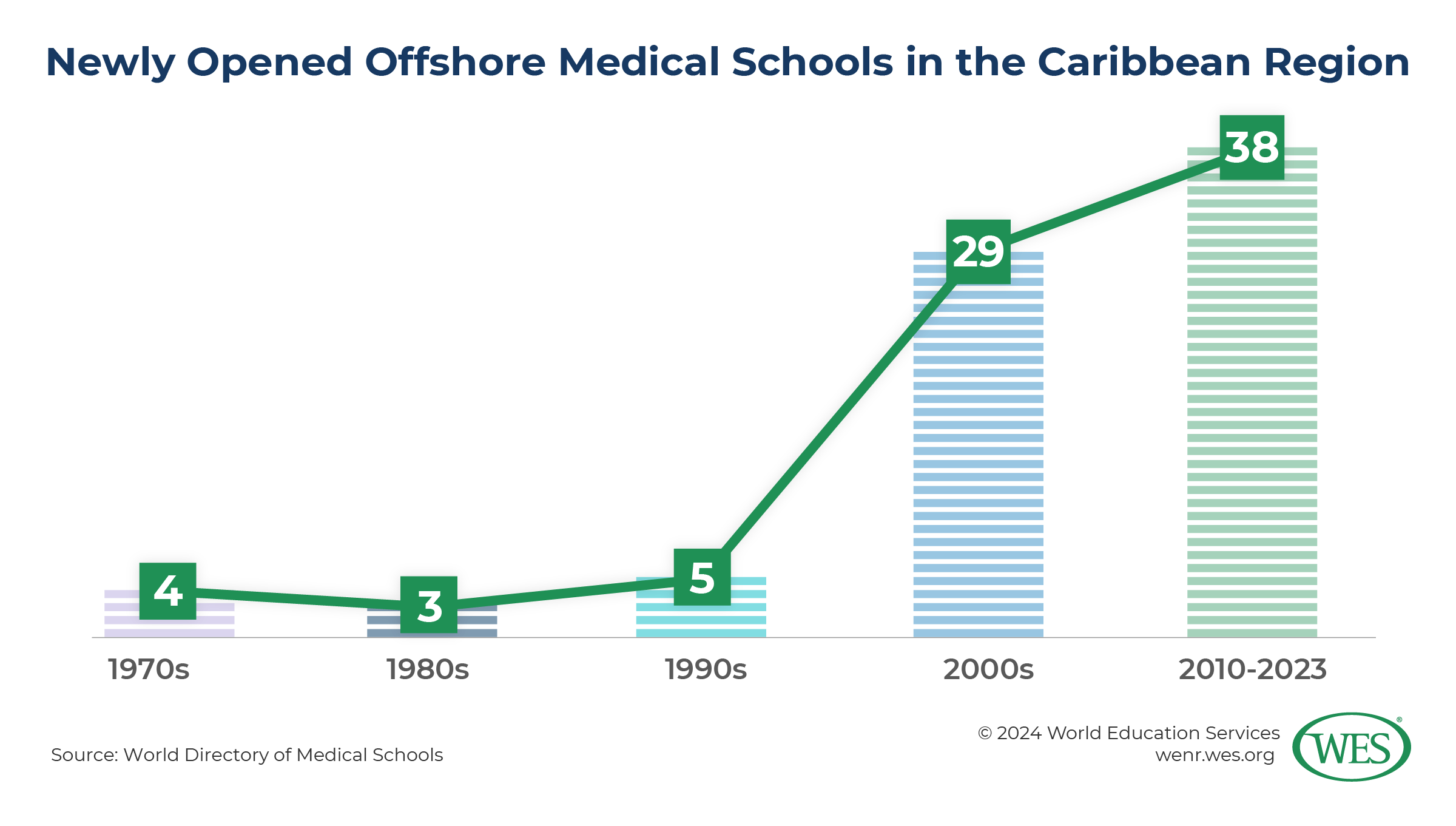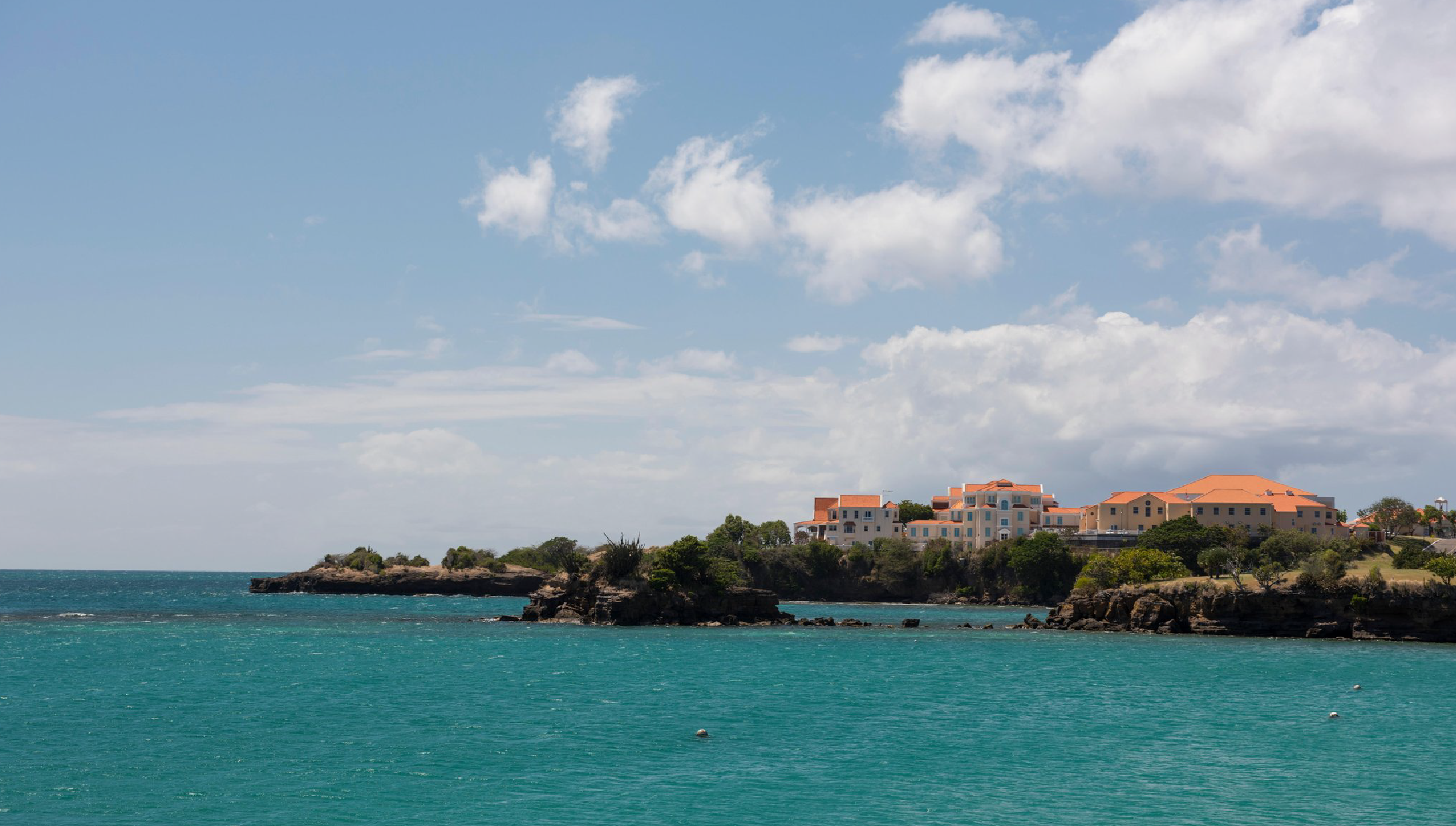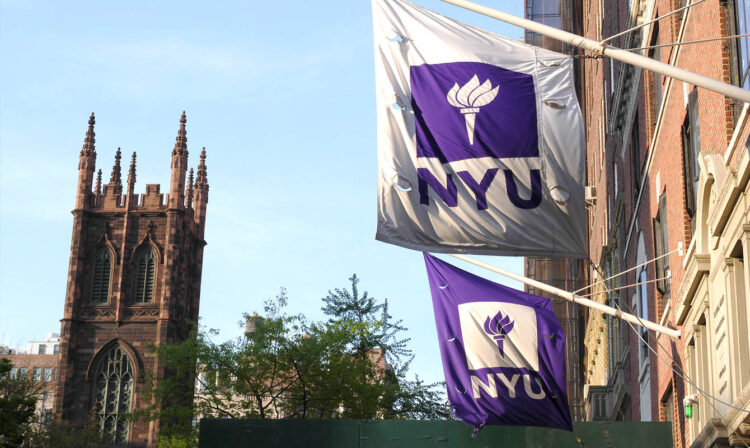Medicine is a fiercely competitive field of education. The average acceptance rate at medical schools in the United States is 5.5 percent and can be as low as 1.4 percent at top institutions like Stanford University School of Medicine. In Canada, some 12,000 students competed over fewer than 3,000 available slots at medical schools in the 2020/21 academic year. This scarcity of open seats causes many U.S. and Canadian students to seek medical education abroad. Thousands of students leave the U.S. and Canada to study medicine in Ireland, the United Kingdom, or in English-taught programs in countries like Poland.
Many of these international students don’t plan to work abroad but intend to return home and obtain medical licensure in the U.S. or Canada. Exactly how many is hard to estimate, but 7,864 out of the 12,912, or three out of every five, international medical graduates (IMGs) who applied for clinical residency training through the U.S. National Resident Matching Program in 2022 were U.S. citizens. For these students, a foreign MD degree is an alternative pathway to becoming a physician if the degree is accepted. Graduates of foreign schools that are approved by the U.S. Educational Commission for Foreign Medical Graduates (ECFMG) are eligible to enroll in accredited clinical internship programs and sit for licensing exams in the U.S.
A sizable share of Americans and Canadians who study medicine abroad attend so-called offshore medical schools. These schools were set up in various Caribbean countries and territories for the purpose of educating international medical students, primarily Americans who couldn’t gain access to medical programs at home. The Caribbean basin has the largest concentration of these types of schools worldwide. Some Caribbean countries now have the highest number of medical schools per capita. The small island nation of St. Kitts and Nevis, for instance, has a population of 48,000 but five medical universities, or around one medical school for every 9,600 people. Canada, in comparison, has 17 medical schools for a population of around 40 million, or about one medical school for every 2.35 million people.
For credential evaluators and licensing professionals, the MD degrees awarded by offshore medical universities (OMUs) can be difficult to assess. Not a single OMU is recognized by the U.S. Liaison Committee on Medical Education (LCME) or the Committee on Accreditation of Canadian Medical Schools (CACMS)—the designated accrediting bodies for medical schools in the U.S. and Canada. The number of OMUs has also spiked in recent years. Players in the offshore market include a few established, well-known providers with a track record since the 1970s but also a diversity of newer copycat schools of varying success. Many offshore providers have just sprung up in recent years; reliable information on these schools can be hard to find, so the quality of their education is difficult to gauge.
This relative lack of information might suggest that offshore medical education is a fringe phenomenon, but it is anything but. By some accounts, more clinical residency positions in the U.S. are currently filled by graduates of large OMUs “than by those of any single U.S. medical school.” Almost 49,000 licensed physicians in the U.S. were educated in Caribbean countries and territories. The number of IMGs from the Caribbean has increased by 115 percent since 2010, and most of them—67 percent—are U.S. citizens.
These statistics reflect that the offshore industry in the Caribbean has become de facto an integral part of the medical education system of the U.S. and Canada, driven by the physician shortages in these countries. Graduates of many OMUs are regularly accepted for clinical residency training and medical licensing in the two countries. U.S. citizens studying at approved OMUs are eligible for federal student loans. In Canada, likewise, many OMUs are approved by the Medical Council of Canada, and students at these institutions can apply for federal financial assistance.
In essence, the unsatisfied demand for medical education in North America has resulted in an accelerated outsourcing trend. Increasing numbers of physicians now receive their basic medical education at overseas schools —at institutions that have less stringent admission requirements and operate under different regulations and quality assurance standards than medical schools in the U.S. and Canada.
To facilitate the understanding of this unique form of transnational education, this article describes the development of offshore medical education in the Caribbean and provides an overview of OMU characteristics and explains why they are prevalent in the Caribbean region. It includes a tally of existing OMUs, as well as a survey of their curricula, admission standards, accreditation status, and acceptance within the medical profession in the U.S. and Canada. Also discussed are upcoming regulatory changes regarding the recognition of OMUs in the U.S.
What Are Offshore Medical Universities?
OMUs are medical schools that predominantly cater to students from other countries than the one in which they operate. Many OMUs in the Caribbean certainly admit local students from Caribbean countries and may even provide scholarships for them, but international students make up the bulk of their student bodies. The population base of some of the small island countries in the Caribbean could not sustain the disproportionately large number of medical schools that exist there.
There is little ambiguity regarding the target market of most OMUs. The websites and marketing materials of these institutions are similar and usually tailored to students from the U.S. and Canada and, to a lesser extent, international students from other countries. Many OMUs prominently advertise on their websites the clinical residency match rates in the U.S. and pass rates of their students in the U.S. Medical Licensing Examination (USMLE). Some also provide information on how to obtain financial assistance in the U.S. and Canada. Testimony to their market focus, several OMUs maintain physical offices in the U.S.
While reliable demographic information on OMU students isn’t available in many cases, it’s clear that most of them are North Americans, respectively U.S. or Canadian residents. Ross University School of Medicine in Barbados, one of the biggest OMUs, states on its website that 98 percent of its 3,000 students are U.S. and Canadian citizens or residents. Likewise, some 80 percent of students at another big OMU, the American University of the Caribbean School of Medicine (AUC) in Sint Maarten, are U.S. citizens and residents, while another 8 percent are Canadians, and 2.5 percent come from Nigeria. In another example, about 68 percent of the 1,000 students of the Saint James School of Medicine, which operates campuses in Anguilla and Saint Vincent and the Grenadines, are U.S. citizens.
Some OMUs increasingly cater not only to Americans and Canadians, but also to students from India and other South Asian countries, where access to medical education is even more limited. These institutions may specify Indian qualifications among their entry requirements and advertise their recognition by the National Medical Commission of India. Some require the Indian medical National Eligibility Cum Entrance Test (NEET) for admission.
There appears to be a certain hierarchy of OMUs in which “students from North America typically attend older, more established schools which may offer an educational program of North American standards and a better chance of matching into a residency program,” whereas students from emerging economies “mainly attend new and developing schools.” Many of the newer OMUs tend to be much more affordable. But while the exact makeup of the student body of these schools is unknown, there’s little doubt that they predominantly recruit international students who seek a pathway to residency and employment in the U.S. and Canada or medical licensure back home.
This focus on educating international students distinguishes OMUs from regular “domestic” medical schools that train physicians to work in local labor markets. The latter include the University of the West Indies in Jamaica, or most medical schools in more populous Caribbean islands like Cuba, the Dominican Republic, Haiti, and the U.S. territory of Puerto Rico. Medical schools in these jurisdictions, as well as most schools in the U.S. and Canada, are typically faculties within larger multi-disciplinary universities, whereas OMUs are generally stand-alone institutions specializing in MD programs.
Another difference is that most OMUs teach the American medical curriculum, in English. OMU programs are generally designed to prepare students for the USMLE or the similar Medical Council of Canada Qualifying Examination (MCCQE). Even OMUs that actively recruit students from other countries, such as India or the U.K., offer the same four-year postgraduate MD program, entered after a bachelor’s degree or three years of undergraduate study, as found in the U.S. and Canada. Medical programs in Cuba, the Dominican Republic, India, Nigeria, the U.K., or the West Indies, in comparison, are usually five- or six-year undergraduate programs.
That said, many OMUs also offer comparable integrated MD programs, which are typically five- to six-year fast-track undergraduate programs designed for high school graduates. Some OMUs award an undergraduate degree in medical sciences en passant to the MD degree.
Why the Caribbean?
The Caribbean region is well suited for OMUs. It’s geographically close to the U.S. and relatively easy to reach. Many of the small, physically isolated countries and territories of the Caribbean have an interest in hosting offshore schools. The kind of “medical education tourism” OMUs give rise to can be very beneficial for the small economies of the Caribbean in terms of taxation, employment generation, import duties, and consumption by students and staff. By some accounts, Grenada derives as much as 19 percent of its GDP from the presence of a large OMU, St. George’s University School of Medicine (SGU).
In 2019, the prime minister of the Bahamas praised the opening of the Western Atlantic University of Medicine as a major development that would diversify the island’s economy and “inject hundreds of millions of dollars into the local economy over time, and provide direct and indirect opportunities for scores of residents.” Given such benefits, some Caribbean countries actively seek to attract OMUs with tax incentives.
Entry into the Caribbean market is relatively easy with comparatively few bureaucratic hurdles for the establishment of offshore schools. Requirements for medical schools there don’t always compare with those mandated in more developed education systems. Some islands have too small a population to even have a higher education sector to speak of. There is consequently limited experience with regulating tertiary education and no well-established process for the quality control of universities.
In many cases, OMUs are not required to obtain formal accreditation by national or external accreditation bodies. Local governments tend to impose few academic regulations on OMUs, since they mostly train international students who don’t stay in the region. Beyond these regulatory advantages, most Caribbean islands offer an English-speaking environment. The tropical setting and palm-fringed beaches of these islands are natural selling points as well.
OMUs in the Caribbean first emerged in the late 1970s when SGU began operations in the small island country of Grenada. Founded in 1976 by an American entrepreneur, SGU remains the only medical school on this island today. It became a model of what has been called “second-chance medical schools” that absorb Americans locked out of the U.S. system. The institution was briefly thrust into the spotlight during the U.S. invasion of Grenada in 1983, which was justified, in part, with the need to protect the 600 American medical students then present on the island. SGU was able to capitalize on this episode and increase enrollment in the wake of this sudden fame.
Today, SGU remains one of the most popular OMUs in the Caribbean with over 1,000 medical graduates each year—a large number compared with most U.S. schools. It is one of a select group of OMUs that are often referred to as the “big four”—the oldest and most reputable offshore providers among several dozens of less successful OMUs. The other three institutions in this group are the Ross University School of Medicine (founded in 1978), the American University of the Caribbean School of Medicine (founded in 1978), and the Saba University School of Medicine on the small Dutch island of Saba, founded in 1992.
For-Profit Providers
Medical education in the U.S. and Canada is mostly provided by public or non-profit private institutions. All of Canada’s 17 medical schools are public providers. In the U.S., for-profit medical education was largely banned for much of the twentieth century—a fact that helped spawn the arrival of offshore providers in the more permissive environment of the Caribbean. This ban on proprietary medical schools was lifted in the 1990s, which means for-profit medical education is now on the rise in the U.S., but it is still rare.
OMUs in the Caribbean, in contrast, are almost all private, for-profit schools. Some are owned by large education corporations like Adtalem Global Education (formerly DeVry Education Group), which currently runs the American University of the Caribbean, and the Ross University Schools of Medicine and Veterinary Medicine. Another U.S.-based firm, R3 Education Inc., described as a “holding company that acquires and manages for-profit educational institutions,” operates the Saba University School of Medicine, the Medical University of the Americas (St. Kitts and Nevis), and St. Matthew’s University in the Cayman Islands. The Indian Manipal Global Health and Education group has made a foray into the offshore market in the Americas as well. It acquired the American University of Antigua in 2008.
The profit margins of successful OMUs are substantial. The American University of the Caribbean sold for US$235 million in 2011. It generated an estimated US$50 million in annual revenues at the time. OMUs have been described as purely “vocational schools”—they generally don’t conduct clinical or scientific research. And the clinical residency training that is part of the medical curriculum usually doesn’t take place in the Caribbean but mainly in hospitals in the U.S. and elsewhere. This means that OMUs have fewer overhead costs for laboratories or clinical and research facilities. Some bigger, more successful OMUs like SGU also have large numbers of students, far exceeding average registration in the U.S., where most medical schools enroll well below 1,000 students.
However, many OMUs are small institutions with less than 50 graduates per year. The economic viability of these smaller schools is less certain and some fold quickly. Eligibility for U.S. federal student loans is a key factor for financial success and sustains the revenues of many OMUs. A DeVry executive told The Hill in 2005 that 80 percent of American students at Ross University received federal financial aid and that the school processed US$53 million in federal loans during that year alone.
For students, education at OMUs can be very expensive, even by U.S. standards. The total outlay for OMUs often includes large administrative fees in addition to tuition. The overall costs of medical education depend on different factors, including housing expenses, time spent to complete the program, and whether students pay in-state or out-of-state rates. Fees charged for clinical rotations are typically higher at OMUs than those for the initial, preclinical stages of the MD program. Annual cost comparisons are also complicated by the fact that some schools have semester systems while others follow a trimester calendar, which OMUs commonly run during the preclinical phase.
However, the total amount of student debt is an approximate indicator of cost. According to the American Medical Association, “median student loan debt accrued for attending an offshore medical school” in 2019 ranged from $191,500 (Ross University School of Medicine) to $253,072 (American University of the Caribbean School of Medicine).” Students at public medical schools in the U.S., in comparison, accrued a median debt of $190,000.
U.S. students, thus, don’t necessarily attend OMUs because they are more affordable but often because it’s easier to get admitted to these schools. On the other hand, there are many OMUs that charge far lower tuition fees than U.S. schools do, and that advertise themselves as a low-cost alternative. OMUs whose students don’t qualify for financial aid in the U.S. or Canada, in particular, tend to be much cheaper. Despite their lack of recognition in North America, the affordability of these schools can be a draw for Americans and other international students.
Some OMUs ensure eligibility for U.S. Title IV federal student loans by partnering with U.S. institutions to offer dual degree programs or concurrent enrollment—a regulatory loophole that allows students to access federal loans via simultaneous enrollment in a U.S. online program, such as a Master of Business Administration or Master of Public Health program. For example, the John F. Kennedy University School of Medicine in Curaçao has partnered with Maharishi International University (formerly the Maharishi University of Management) and Walden University in the United States. It advertises on its website that dual enrollment qualifies students for federal loans. There are at least 18 OMUs that have these kinds of arrangements, most of them with Walden University, as well as with Franklin University, headquartered in Ohio. The U.S. partner institutions offer OMU students a tuition discount for enrolling in their programs.
Number of OMUs in the Caribbean
The number of OMUs in the Caribbean depends on how narrowly one defines the Caribbean region. Beyond the islands of the Greater and Lesser Antilles, there are OMUs in the Lucayan (Bahamian) Archipelago and continental countries bordering the Caribbean Sea, notably in Belize and Guyana. We have included these institutions in this article since they provide the same type of education and follow the same business model. In fact, OMUs make up a majority of medical education providers in these small countries, which are culturally often considered part of the Caribbean, and are part of the Caribbean Community (CARICOM)—an intergovernmental organization of 15 Caribbean countries and territories.
While we believe that our tally represents an exhaustive list of OMUs in the Caribbean, we don’t presume that it includes each and every school that provides U.S.-modeled medical education for international students. The Universidad Autónoma de Guadalajara School of Medicine, for example, is considered one of the first offshore medical schools in the Americas, but because of its location in western Mexico it isn’t included here.
For reference, a list of all institutions discussed here as OMUs is attached at the end of this article. The list includes both current and defunct providers. It is based on the World Directory of Medical Schools (WDOMS), cross-referenced with institutional websites and other information. The Foundation for Advancement of International Medical Education and Research, which partially manages WDOMS, published a similar list of OMUs in 2014. Another helpful resource on OMUs, particularly from an accreditation perspective, is a recent analysis and listing published by AACRAO.
According to our tally, there are presently 61 functional OMUs in the larger Caribbean region, operating in 19 countries and territories. This compares with 192 operational medical schools in the U.S. and 17 in Canada. As shown in the chart below, the number of new OMUs has jumped markedly since the 1970s. Whereas there were only 6 Caribbean OMUs in the 1980s, 29 opened in the 2000s, followed by 38 between 2000 and 2023. Six OMUs opened within the past three years alone. The largest numbers of OMUs are in Barbados (8), Guyana (7), and Saint Lucia (6).
The cluster of OMUs in the Caribbean is characterized by fluctuation. As noted, medical schools there can be set up comparatively quickly, yet may shutter within years after opening. Since OMUs are run by private companies and are sometimes later acquired by new owners. Some institutions reopen under different names, relocate, or branch out to other countries in the region. For instance, the American University of Integrative Sciences School of Medicine in Barbados was first founded on the island of Sint Eustatius under the name University of Sint Eustatius School of Medicine, then changed its name and operated in Sint Maarten for a few years, before it was bought out by another company and located to Barbados in 2017.
Political developments have had an impact on some OMUs. After the dissolution of the Netherlands Antilles in 2010, the islands of Bonaire, Sint Eustatius, and Saba came under the direct administration of the Netherlands, which required medical schools there to seek Dutch accreditation. As a result, most OMUs on these islands relocated to other jurisdictions in the region. The only institution that successfully obtained Dutch accreditation of its MD program was the Saba University School of Medicine.
Note that a handful of schools listed in WDOMs have defunct websites, so that it’s uncertain whether these schools were functional at the time of this writing. Unless we could substantiate elsewhere that these institutions were operational, we excluded them from our tally. Some of these schools seem to be fly-by-night providers whose legal status is dubious.1
Guyana is a somewhat unusual case in that several of the schools there appear to mainly serve students from India.2 Lincoln American University School of Medicine, for example, has office locations in India, Bangladesh, and Sri Lanka, as well as partnerships with hospitals and health care providers in India and Nepal. It advertises that its curriculum follows Indian regulatory guidelines and is recognized in India. Some institutions in Guyana also offer a range of programs beyond the standard MD, making them more difficult to classify. The Twin Island University School of Medicine, for example, promotes itself as an “offshore medical school … that caters primarily to foreign as well as local Guyanese students” who wish “to practice medicine in the US and Canada.” At the same time, the school offers bachelor and master programs in engineering, chemistry, and physics, as well as a Doctor of Philosophy degree in science.
Admission Requirements
The comparatively relaxed admission requirements of OMUs are key to their growing popularity. Like medical schools in the U.S., OMUs generally require a bachelor’s degree or three years of undergraduate study with adequate credits in science subjects and mathematics for admission into their postgraduate MD programs. However, whereas the average undergraduate GPA of matriculants at U.S. medical schools in 2023 was 3.77, GPA requirements at OMUs range from 3.3 at established schools like SGU to only 2.0 at lower-tier schools.3
The admission standards of OMUs vary significantly but most of them don’t have entrance examinations. Established schools like the “big four” may state that they conduct admissions interviews or prefer that applicants have some form of prior clinical experience. The Medical College Admission Test (MCAT)—a standard requirement at most U.S. schools—is only mandated by a handful of OMUs, such as SGU, Ross University, or AUC. (This requirement is generally only for U.S. citizens and residents, with minimum score requirements at the lower end of the spectrum).
In some cases, applicants may be asked to submit MCAT scores, but the test results aren’t factored into admission decisions. In other cases, the submission of MCAT scores is explicitly “not required” or “optional.” For applicants from non-English-speaking countries, the TOEFL (Test of English as a Foreign Language) or similar proficiency exam may or may not be needed. One school proudly advertises that the “TOEFL, IELTS, SAT, ACT, or MCAT or any other Equivalent Standardized Test … are not required at all.” By some accounts, admission rates at OMUs are 10 times higher than at U.S. schools. Some OMUs employ aggressive recruitment tactics and overenroll unqualified students, resulting in high attrition rates.
Beyond permissive admission requirements, there are a few U.S. universities that facilitate the offshoring of medical education through partnerships with OMUs. Some U.S. institutions have signed agreements with OMUs that ease the transition of their undergraduate students into offshore MD programs. Students at these feeder institutions can get direct and expeditious admission into partner OMUs upon completion of their undergraduate degree.
Program Structure and Curricula
A description of the MD programs offered by OMUs need not be extensive, for most OMUs teach the same curriculum as medical schools in the U.S. and Canada, often using the same textbooks. Professors are often U.S.-educated, holding MD or PhD degrees, but are said to be paid lower salaries than instructors at U.S. schools.
The first four or five semesters of the MD program cover the basic science curriculum and include coursework in subjects like anatomy, biochemistry, epidemiology, microbiology, histology, pathology, or physiology. Students then sit for the USMLE Step 1 exams—a passing score is a prerequisite for continuing to the next, clinical stage of the program. The final semester of the pre-clinical phase is often devoted specifically to prepping students for the exam.
The second phase—the clinical science or clerkship curriculum—involves supervised clinical training in medical specialties like internal medicine, pediatrics, surgery, emergency medicine, radiology, or ophthalmology. This phase usually lasts two years, leading to the USMLE Step 2 exam. The residency training usually takes place at partner hospitals in the U.S., Canada, or other countries (see below).
After passing the exam and fulfilling all other school requirements, graduates are awarded a Doctor of Medicine degree (MD). To become licensed in the U.S., candidates still need to obtain ECFMG certification, complete a one-year clinical internship, and pass a third USMLE exam. These final steps are taken independently and are not supervised by a medical school.
In addition to the standard U.S. MD program, many OMUs also offer integrated five-, five and a half-, or sometimes six-year undergraduate programs for high school graduates. Applicants who don’t have the required undergraduate science credits for the postgraduate MD program can acquire these credits in an accelerated premedical phase lasting one or one and a half years, which is then followed by the standard medical curriculum.
Offshore Veterinary EducationA handful of OMUs offer programs leading to a Doctor of Veterinary Medicine (DVM). Depending on the program, offshore DVM programs have less stringent admission requirements than U.S. schools and can be completed in less time but tend to be expensive in terms of tuition. Veterinary medicine requires fewer clinical facilities than human medicine, which means that these facilities are less costly to operate, and some OMUs have established their own on-site veterinary teaching hospitals in the Caribbean. Offshore veterinary schools include St. Matthew’s University School of Veterinary Medicine in the Cayman Islands, Ross University, and SGU. The latter two are accredited by the American Veterinary Medical Association. |
In other cases, the premedical component is more extensive, and a Bachelor of Health Sciences or similar degree may be awarded en passant to the MD, respectively as a standalone degree. This allows students to earn a bachelor’s degree after two or three years of study. Part of these programs may be studied in distance mode. Some OMUs also offer bachelor degree programs in nursing and public health.
Integrated programs are more akin to undergraduate medical degree programs found in other countries, such as India. The admission requirements for these programs may therefore be less specifically tailored to U.S. students and list a range of secondary school qualifications from different countries. Depending on the institution, Indian applicants may need to submit scores from the Indian NEET in addition to holding an Indian 10+2 upper-secondary qualification. The NEET is mandatory for returning Indian students to obtain licensure in India.
Clinical Clerkship Training
Most OMUs don’t have extensive clinical facilities and usually don’t utilize local teaching hospitals, which are limited in number in the Caribbean. Instead, they outsource the clinical clerkship training to hospitals in other countries, mainly the U.S., but also various other countries like Canada, Ireland, New Zealand, Saudi Arabia, South Africa, the U.K., or even Nepal.
OMUs have partnerships with hospitals all over the U.S., including in California, Connecticut, Florida, New Jersey, Puerto Rico, and Texas. The largest number of OMU students undergo clinical training in New York, where some of the big OMUs have secured large-scale contracts with local hospitals.
These partnerships can be very lucrative for hospitals since OMUs purchase residency slots at high prices, whereas clerkship training for students at U.S. schools is provided either free of charge or for comparatively small fees at public hospitals. In 2008, SGU signed a 10-year $100 million contract for up to 600 residency slots with New York City’s Health and Hospitals Corporation, a public benefit corporation that runs the public hospitals and clinics in the city. In another example, Ross University in 2012 secured around 100 residency slots for $35 million over 10 years in an agreement with Kern Medical Center, a public teaching hospital in California.
These pay-for-play practices have been decried as a monetization of medical training to the detriment of U.S. students. One observer noted at the time that “checkbook-carting Caribbean schools could edge out their non-paying U.S. counterparts, squeezing American students out of [clinical] rotations. Some predict the U.S. schools eventually will have to pony up cash, too, thereby increasing already high medical school costs.” Public medical universities in New York are indeed reported to have lost residency slots at hospitals contracted by OMUs.
Accreditation
As discussed further below, U.S. authorities are currently introducing regulatory changes that will incentivize OMUs to obtain accreditation by external accreditation agencies. As it stands, however, many OMUs in the Caribbean only need a license to operate, which may be granted by governmental charter or an act by local parliament. In some cases, maintaining a license may be contingent on accreditation by national or international accrediting bodies, but in other cases it is not. The Barbados Accreditation Council, for instance, permits all OMUs on the island to operate as registered education providers, but has granted formal accreditation to only one of them. The accreditation board of St. Kitts and Nevis, on the other hand, has granted accreditation to all OMUs operating there. Some Caribbean jurisdictions don’t have dedicated accreditation agencies at all. In Saint Lucia, home to a large number of OMUs, an accreditation council for tertiary institutions wasn’t set up until 2020 and wasn’t fully operational as of this writing.
To establish more coherent quality standards, several Caribbean countries have created a joint accreditation mechanism for medical programs in the form of the Caribbean Accreditation Authority for Education in Medicine and Other Health Professions (CAAM-HP), a regional accreditation body established in 2003 under the auspices of CARICOM. CAAM-HP accreditation certifies that medical programs meet set quality standards. The body’s accreditation requirements stipulate that MD programs include a minimum of 130 weeks of instruction over at least four calendar years, in addition to certain minimum standards for educational facilities, the content of the curriculum, assessment methods, and the qualifications of teaching staff. Admission must be based on an undergraduate degree or “an adequate level in the sciences.”
However, most OMUs are currently not accredited by CAAM-HP. The commission’s published list of assessed programs shows that several OMUs have been rejected, lost their accreditation, or withdrew voluntarily. Others have obtained only conditional accreditation thus far. While CAAM-HP accreditation is open to institutions from non-CARICOM member states, big OMUs like AUC and the Saba University School of Medicine have not applied for accreditation. SGU in 2021 withdrew from CAAM-HP after it previously held probationary accreditation. The school states on its website that it withdrew voluntarily because this type of accreditation wasn’t “needed for access to U.S. Federal Direct Student Loans” and other benefits.
Some OMUs have ventured far away from the Caribbean to obtain accreditation by the Accreditation Commission on Colleges of Medicine (ACCM), a little-known independent private agency located in Ireland that was established in 1994, before the creation of CAAM-HP. ACCM states that it “serves countries which may not have a medical accreditation body of its own.” It presently only accredits 10 institutions—nine OMUs in the Caribbean and one medical school in Bahrain.
For these OMUs, accreditation by ACCM is valuable because it facilitates their recognition in the United States. ACCM is considered a “comparable foreign accreditor” by the U.S. National Committee on Foreign Medical Education and Accreditation (NCFMEA). This committee, housed under the federal Department of Education, is tasked with “determining whether the standards of accreditation used by a foreign country to accredit medical schools, are comparable to standards applied to medical schools in the United States.” Since ACCM is deemed comparable, American students enrolled at ACCM-accredited institutions are eligible to access federal student loans—an important financial factor for OMUs since this access greatly facilitates the recruitment of U.S. students. The NCFMEA currently lists ACCM as a bona fide accreditor for the Cayman Islands, St. Kitts and Nevis, and Sint Maarten.
Of note, several OMUs advertise their listing in WDOMS in the accreditation information sections on their websites. This kind of marketing can be misleading, since WDOMS is not an accrediting body. Being listed in WDOMS by itself “does not denote recognition, accreditation, or endorsement by the World Directory of Medical Schools or by its partner organizations.” To be listed in WDOMs, a school only needs to be officially licensed or chartered in their respective country or territory.
Other forms of questionable marketing can be found on some OMU websites as well. CAAM-HP in 2019 noted that “certain medical schools in Antigua & Barbuda, Belize, St Vincent & The Grenadines, and Guyana have been making false claims of being accredited by CAAM-HP and, in one case, a particular school had even gone to the extent of issuing a bogus certificate, bearing what was purported to be the signatures” of CAAM executives.
Acceptance of OMUs in the U.S. and Canada
The outcomes of offshore education can be disappointing for medical students seeking to obtain a clinical residency and to practice medicine in the U.S. or Canada. On their websites, OMUs paint a rosy picture, underpinned by cherry-picked statistics on residency match and USMLE pass rates. But the reality often looks very different. William Pinsky, president of ECFMG until late 2023, told the New York Times in 2021 that students were “being taken advantage of by schools that may not give them proper information as to how they’re going to learn and what their opportunities are going to be when they finish school.” Graduation rates, for example, are substandard even at the best OMUs, reportedly ranging between 50 and 80 percent compared with 90 to 95 percent at U.S. schools. Student-to-faculty ratios and attrition rates are said to be higher, and more students fail to graduate on time.
After graduation, holders of offshore degrees may face scrutiny and rejection due to the poor reputation of OMUs in the U.S., where they are often viewed as shoddy providers. Surveys of hospital administrators show that U.S. IMGs are far less likely to be invited to application interviews than U.S. graduates. Moreover, offshore students pass the USMLE licensing exams at lower rates and get accepted for clinical internship training in proportionately fewer numbers. In 2022, the U.S. Federal Trade Commission ordered Saint James School of Medicine to pay US$1.2 million in refunds because it deceptively inflated these statistics. Whereas the school advertised a USMLE Step 1 pass rate of 96.77 percent, in fact only 35 percent of Saint James students have passed the exam since 2017. The residency match rate for graduates was only 63 percent, not the 83 percent promoted by Saint James.
Pass rates are said to be significantly higher for students at top-tier OMUs like the “big four,” but they are still not on par with the pass rates of top U.S. schools. While public USMLE performance data do not distinguish between countries or institutions, the overall pass rate for students enrolled in foreign schools in the 2022 USMLE Step 1 exam was 74 percent, whereas it was 91 percent for U.S. and Canadian students. In Step 2, 86 percent of internationally educated examinees passed the exam compared with 98 percent of examinees educated in the U.S. and Canada.
In terms of residency match rates, U.S. IMGs outperform IMGs from other countries, but they are less successful in securing residencies than U.S. graduates. In 2023, 67.7 percent of U.S. IMGs matched into postgraduate residency programs compared with 93.7 percent of graduates from U.S. and Canadian schools.4 The likelihood of matching depends on the medical specialty, as well as on the U.S. state where the residency training takes place. Offshore graduates are less likely to obtain residencies in the most competitive medical fields and in more restrictive states. Medical doctors in the U.S. are licensed by state authorities, and some states have additional requirements beyond ECFMG certification.
Given these difficulties, consultancy agencies have sprung up that advise applicants on which residency programs and states are “IMG friendly.” Internal medicine is considered the most IMG-friendly specialty, alongside family medicine, pathology, and pediatrics. In terms of total numbers, most IMGs enter residencies in New York, Florida, and Pennsylvania. That said, obtaining a residency position alone is not always enough. In several states, IMGs must complete one or two more years of postgraduate clinical training than U.S. graduates before qualifying for licensure. Once licensed in one state, IMGs can then typically practice in various other states because of reciprocity agreements.
Eligibility for ECFMG Certification
Given the qualitative disparities between OMUs, the success of offshore students often depends on the school they attend, with OMUs being unofficially ranked into different tiers based on their reputation. However, ECFMG certification is a hard criterion for every IMG to be permitted to enter accredited postgraduate residency programs in the U.S. and sit for the final USMLE Step 3 exam. The foreign school at which a candidate studied must be approved by ECFMG. To be approved by ECFMG, medical schools must, at minimum, “be recognized as a medical school by the appropriate government authority in the school’s host country, and the degree awarded to its graduates must meet the medical education eligibility requirements for licensure to practice medicine in that country.” In addition, the MD programs offered by the school must be at least four years in length.
As of January 2024, the ECFMG listed on its website 19 Caribbean OMUs among the foreign schools eligible for ECFMG certification. In addition, approved schools are also identified in WDOMS, which is partially sponsored by ECFMG. A “sponsor note” denoting ECFMG acceptance is included in the WDOMS directory for approved schools. This sponsor note may be limited to specific time periods (which is mostly the case for closed schools). Sponsor notes can also be withdrawn. WDOMS data for some OMUs include annotations that these schools are ineligible for ECFMG certification, or that they provided “false information and documents to ECFMG.”
Upcoming Regulatory Changes
ECFMG is currently updating its approval criteria for foreign medical schools—a change that is slated to be completed in late 2024. In an effort to advance accreditation standards for medical schools, ECFMG approval of foreign schools will be based on their accreditation by an agency that must itself “be reviewed and recognized by an external quality assurance organization.” In practice, this means that schools must be accredited by an agency that is recognized by the World Federation for Medical Education (WFME), an important international non-governmental organization that seeks to improve global quality standards in medical education. A simple operating license granted by a particular government does not satisfy the requirements of the ECFMG’s new “recognized accreditation policy.”
Going forward, approved schools will be identified as having “recognized accreditation status” in the WDOMS sponsor note. This change will not impact OMUs that currently hold accreditation by CAAM-HP or ACCM, accepted national accreditors, or other recognized accrediting bodies, such as the Dutch NVAO. However, OMUs without these types of accreditations are now incentivized to obtain them or risk losing market share. A list of WFME-recognized accreditors can be found here. The only national accrediting body in the Caribbean recognized by WFME is the Grenada Medical and Dental Council, which gained recognition in 2022. Graduates of OMUs in other Caribbean countries that don’t have accreditation by a recognized external agency will likely find it difficult to obtain ECFMG certification in coming years.
Recognition in Canada
In Canada, graduates of OMUs face even steeper hurdles than in the United States. Canadian authorities seek to ensure that graduates of Canadian schools have access to residency training, and so they limit the number of available slots for IMGs with a quota system set by the country’s provinces. Unlike graduates of Canadian schools, IMGs must also pass two exams instead of one to apply for residency programs through the Canadian Residency Matching Service (CaRMS). In addition to the Medical Council of Canada Qualifying Examination (MCCQE) Part I, which is required for all applicants, IMGs must also pass the National Assessment Collaboration (NAC) Examination—a test that measures the readiness of IMGs for postgraduate training in Canada.
Canada follows an approach similar to that of U.S. authorities when it comes to the recognition of foreign medical schools. While provincial regulatory bodies in Canada set their own licensing criteria, IMGs that want to become licensed in Canada must have a degree from a school that is recognized by the Medical Council of Canada (MCC). The MCC has not published its assessment criteria, but it generally recognizes the same OMUs as the U.S. ECFMG. As in the case of the U.S., a Canada sponsor note is attached to recognized schools in the WDOMS directory, indicating that medical degrees obtained from these schools “are acceptable to the provincial/territorial medical regulatory authorities in Canada, and therefore acceptable to all medical organizations in Canada.” Recognized schools listed in WDOMS usually include both the ECFMG and Canadian sponsor note. It’s unclear if the ECFGM’s new recognized accreditation policy will influence recognition standards in Canada going forward.
There is less quantitative data available on Canadians studying medicine abroad than for U.S. IMGs. However, their number has grown steadily in recent years. About 50 percent of the IMGs that sat for the 2017 NAC exam—767 candidates—were born in Canada or were permanent Canadian residents. At least 19 percent of these candidates were educated in Caribbean countries and territories.
IMGs (from all countries) pass Canadian licensing exams and match into residencies at significantly lower rates than graduates of Canadian schools. Whereas 93 percent of Canadian-educated first-time test takers passed the MCCQE1 in 2023, only 59 percent of IMGs did. Likewise, 93.5 percent of Canadian-educated candidates in 2023 matched into first-year postgraduate residencies through CaRMS compared with 72.3 percent of IMGs.5 The published CaRMS data are only broken down by region, not by individual countries. But candidates educated in the Caribbean and Central America matched at lower rates (29 percent) than candidates educated in Europe and South America, which succeeded at a rate of 60 and 41 percent, respectively.6 OMUs are often viewed as low-quality providers in Canada: Interviews of Canadian medical education professionals show that OMUs tend to be held in lower regard than Canadian schools; many Canadian IMGs educated in the Caribbean are said to practice in the U.S. or elsewhere instead of returning to Canada because of the difficult career prospects they encounter there.
| Offshore Medical Universities (OMUs) | ||
| Institution by Country/Territory | Year Education Commenced | Currently Operational (Yes/No) |
| Anguilla | ||
| American University of Anguilla School of Medicine | 2022 | Y |
| Saint James School of Medicine Anguilla | 2010 | Y |
| Antigua and Barbuda | ||
| American University of Antigua College of Medicine | 2004 | Y |
| Atlantic University School of Medicine | 2017 | Y |
| Metropolitan University College of Medicine | 2017 | Y |
| University of Health Sciences Antigua School of Medicine | 1983 | Y |
| Aruba | ||
| American University School of Medicine Aruba | 2018 | Y |
| Aureus University School of Medicine | 2004 | Y |
| Bay University School of Medicine | 2020 | Y |
| Nucleus University School of Medicine | 2021 | Y |
| Xavier University School of Medicine, Aruba | 2004 | Y |
| Bahamas | ||
| Western Atlantic University, School of Medicine | 2022 | Y |
| Barbados | ||
| American University of Barbados School of Medicine | 2011 | Y |
| American University of Integrative Sciences School of Medicine | 1999 | Y |
| Bridgetown International University School of Medicine | 2019 | Y |
| International University of Barbados School of Medicine | 2017 | Y |
| Queen’s University College of Medicine | 2018 | Y |
| Ross University School of Medicine | 1978 | Y |
| Victoria University of Barbados School of Medicine | 2019 | Y |
| Washington University of Barbados School of Medicine | 2016 | Y |
| Belize | ||
| American Northwest University | 2018 | Y |
| Avicina Medical Academy | 2012 | N (date of closure unknown) |
| Columbus Central University School of Medicine | 2006 | Y |
| Grace University School of Medicine | 2000 | N (closed 2004) |
| Hope University School of Medicine | 2005 | N (closed 2007) |
| InterAmerican Medical University | 2003 | N (closed 2011) |
| Medical University of the Americas | 2001 | N (closed 2010) |
| St. Luke’s University School of Medicine | 2002 | N (closed 2007) |
| St. Matthew’s University School of Medicine | 1997 | N (closed 2002) |
| Washington University of Health and Sciences | 2012 | Y |
| Bonaire | ||
| International University School of Medicine | 2010 | Y |
| Cayman Islands | ||
| St. Matthew’s University School of Medicine | 1997 | Y |
| Curacao | ||
| Avalon University School of Medicine | 2003 | Y |
| Caribbean Medical University School of Medicine | 2007 | Y |
| John F. Kennedy University School of Medicine | 2014 | Y |
| New York Medical University School of Medicine | 2017 | Y |
| St. Martinus University Faculty of Medicine | 2003 | Y |
| Dominica | ||
| All Saints University School of Medicine, Dominica | 2006 | Y |
| American Canadian School of Medicine | 2023 | Y |
| St. Joseph University School of Medicine and Allied Health Sciences | 2022 | Y |
| Grenada | ||
| St. George’s University School of Medicine | 1977 | Y |
| Guyana | ||
| Alexander American University School of Medicine | 2016 | N (Closed 2018) |
| American International School of Medicine | 2000 | Y |
| American School of Medicine | 2022 | Y |
| Georgetown American University School of Medicine | 2014 | Y |
| GreenHeart Medical University School of Medicine | 2005 | Y |
| Lincoln American University School of Medicine | 2017 | Y |
| Rajiv Gandhi University of Science and Technology School of Medicine | 2012 | Y |
| Twin Island University School of Medicine | 2014 | Y |
| Jamaica | ||
| Caribbean School of Medical Sciences | 2015 | Y |
| Montserrat | ||
| Seoul Central College of Medicine | 2003 | N (date of closure unknown) |
| University of Science, Arts & Technology (USAT) Faculty | 2003 | Y |
| Vanguard University School of Medicine | 2014 | Unclear |
| Saba | ||
| Saba University School of Medicine | 1993 | Y |
| St. Kitts and Nevis | ||
| Burnett International University School of Medicine and Health Sciences | 2006 | N (closed 2010) |
| Grace University School of Medicine | 1984 | N (closed 1999) |
| International University of the Health Sciences | 1998 | Y |
| Medical University of the Americas | 2000 | Y |
| Milik University | 2005 | N (closed 2010) |
| Saint Theresa’s Medical University | 2005 | N (closed 2009) |
| Universal Caribbean University School of Medicine | 2018 | Y |
| University of Medicine and Health Sciences, St. Kitts | 2008 | Y |
| Windsor University School of Medicine | 2000 | Y |
| Saint Lucia | ||
| American International Medical University School of Medicine | 2007 | Y |
| Atlantic University School of Medicine | 2010 | N (closed 2017) |
| College of Medicine and Health Sciences, St. Lucia | 2001 | Y |
| Commonwealth University College of Medicine | 2019 | Y |
| International American University College of Medicine | 2004 | Y |
| Spartan Health Sciences University School of Medicine | 1980 | Y |
| St. Helen University School of Medicine | 2012 | N (closed 2014) |
| St. Mary’s School of Medicine | 2003 | N (date of closure unknown) |
| Washington Medical Sciences Institute | 2011 | Y |
| St. Vincent and the Grenadines | ||
| All Saints University School of Medicine | 2012 | Y |
| Kingstown Medical College | 1979 | N (closed 2007) |
| Richmond Gabriel University College of Medicine | 2011 | Y |
| Saint James School of Medicine St. Vincent and the | 2000 | Y |
| Saint Teresa University School of Medicine | 2019 | Y |
| Trinity School of Medicine | 2008 | Y |
| Sint Maarten | ||
| American University of the Caribbean School of Medicine | 1978 | Y |
1. One such case is the North Shore Medical Institute in Guyana, no trace of which exists on the internet despite its being listed in WDOMS as a medical school established in 2023. It is not listed by Guyana’s National Accreditation Council as of this writing. The administrator of a medical school that previously operated under the name North Shore was in 2016 investigated for fraud and has been accused of operating illegitimate medical schools under different names in the past.
2. While it’s unclear if this is an important factor, Guyana has the largest number of people of Indian heritage in the Caribbean region after Trinidad and Tobago. Indo-Guyanese make up the largest ethnic group there, accounting for some 40 percent of the population, according to Guyana’s latest census.
3. Minimum GPA requirements aren’t always reported by OMUs but are well publicized by various admissions consulting agencies.
4. Data from the National Resident Matching Program (NRMP), through which most candidates obtain residencies in the U.S. Note, however, that it is technically possible to be accepted to a residency position outside the NRMP Match.
5. The match rates of both IMGs and Canadian graduates drop further when looking at results in the second test round (iteration), as well as for candidates who graduated in the previous year. In 2023, 90.4 percent of previous year Canadian-educated graduates matched into residencies through CaRMS compared with 30.1 precent of IMGs. In the second test iteration, 60.6 percent of Canadian medical graduates matched compared with 39 percent of IMGs.
6. Note, however, that candidates educated in Central America and the Caribbean outperformed candidates educated in the Middle East (23 percent), Asia (25 percent), and Africa (28 percent).
The views and opinions expressed in this article are those of the author(s) and do not necessarily reflect the official policy or position of World Education Services (WES).
